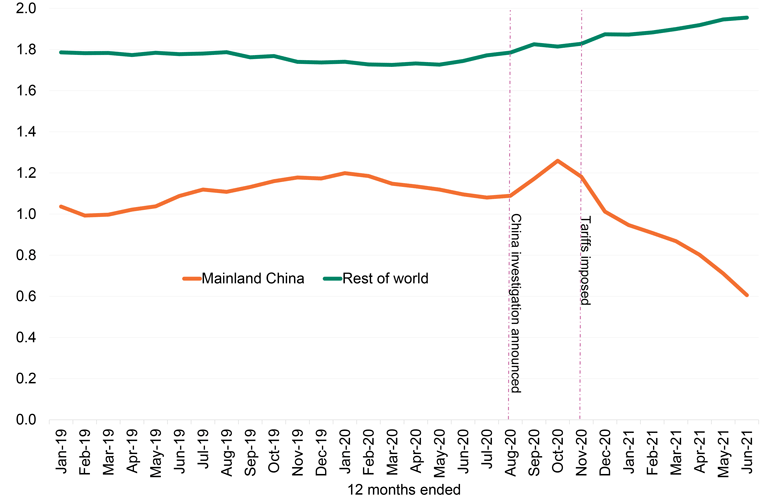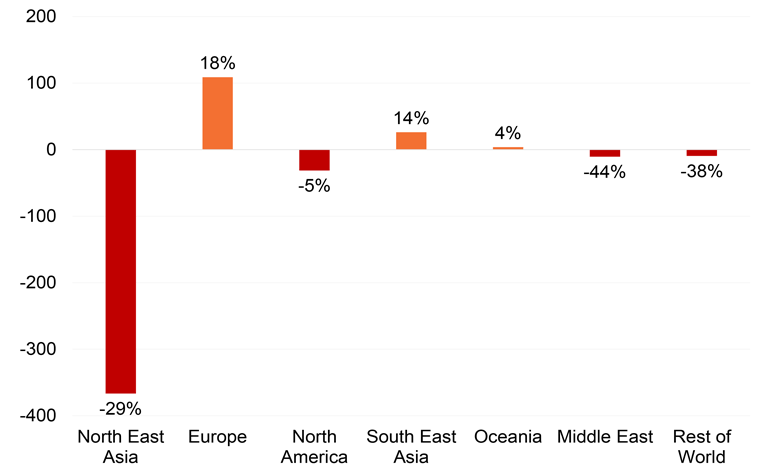Australian wine exports during 2020–21 declined by 10 per cent in value to $2.56 billion, compared with the previous financial year, while export volume declined by 5 per cent in volume to 695 million litres (77 million 9-litre case equivalents), according to Wine Australia’s latest Export Report released today.
The average price per litre for wine exports declined by 5 per cent to $3.69 free on board (FOB).
Wine Australia General Manager Corporate Affairs and Regulation Rachel Triggs said the key factors in the declines were the downturn in exports to mainland China following the imposition of tariffs[1] and the cumulative effects of three consecutive lower vintages in 2018, 2019 and 2020 which meant there was less wine available to export.
Ms Triggs said exports to the UK were at their highest level in a decade, with the value of exports increasing by 23 per cent to $472 million and volume by 16 per cent to 269 million (30 million 9-litre case equivalents), making the UK the biggest destination for exports by volume and the second by value.[2]
“Exports increased to the UK, Singapore, South Korea, Malaysia, Taiwan and Hong Kong by a combined $240 million, but they did not offset the decline in exports to mainland China,” Ms Triggs said.
“However, excluding mainland China, exports increased by 12 per cent in value to $1.96 billion and increased by 6 per cent in volume to 643 million litres.”
Figure 1: Exports over time (Billion AUD FOB) – mainland China versus Rest of the World
 Ms Triggs explained that the decline in the overall average value was due to a drop in the share of bottled exports; from 45 per cent of the share of volume in 2019–20 to 39 per cent in 2020–21. This again was an impact of the mainland China market as it had predominantly been a bottled wine market, and also the growth in exports to the UK which was dominated by unpackaged exports which were bottled in-market.
Ms Triggs explained that the decline in the overall average value was due to a drop in the share of bottled exports; from 45 per cent of the share of volume in 2019–20 to 39 per cent in 2020–21. This again was an impact of the mainland China market as it had predominantly been a bottled wine market, and also the growth in exports to the UK which was dominated by unpackaged exports which were bottled in-market.
The most significant growth came in exports to Europe (including UK), up 18 per cent to $724 million, the highest value since 2010–11. There was also growth to South East Asia, up 14 per cent to $207 million and Oceania, up 4 per cent to $107 million. The growth to these destinations was offset by the decline to Northeast Asia (which includes mainland China), down 29 per cent to $909 million, as well as to North America down 5 per cent to $586 million.
Figure 2: Change in value of exports by region (A$ million FOB)

Destinations
The top five markets by value were:
- Mainland China, down 45 per cent to $606 million
- United Kingdom (UK), up 23 per cent to $472 million
- United States (US), down 7 per cent to $400 million
- Hong Kong, up 111 per cent to $187 million, and
- Canada, down 1 per cent to $184 million.
The top five destinations by volume were:
- UK, up 16 per cent to 269 million litres
- US, down 8 per cent to 127 million litres
- Mainland China, down 57 per cent to 52 million litres
- Canada, down 5 per cent to 51 million litres, and
- Germany, up 14 per cent to 36 million litres.
United Kingdom
The growth in exports to the UK was much stronger in the first half of the year, due to the surge in wine sales in the off-trade sector spurred by the COVD-19 related shut-down of the on-trade as well as some exporters sending wine into the market ahead of Brexit. Exports to the UK increased by 40 per cent to $255 million in the first half of the financial year and by 8 per cent to $218 million in the second half. While growth in the second half was at a much lower rate, the growth in Quarter 4 (up 10 per cent) was stronger than Quarter 3 (up 6 per cent).
Mainland China
Since the imposition of import tariffs, exports of Australian wine to mainland China have dropped dramatically. Total exports for Quarters 3 and 4 in 2020–21 were $13 million compared to $419 million in 2019–20, prior to the imposition of tariffs.
United States
Exports to the US declined 7 per cent in value to $400 million and by 8 per cent in volume to 127 million litres (14 million 9-litre case equivalents). The average value increased by 1 per cent to $3.13 per litre, the highest for a financial year since 2008–09.
Most of the decline in export value came in Quarter 4, with value falling by $31 million compared to the same quarter in 2019–20. The decline is the result of several factors. Firstly, there was a substantial increase in exports in Quarter 4 in 2019–20, which was a reflection of the COVID-19-related surge in off-trade sales in the US when the on-trade sector was shut-down. This year, with the on-trade re-opening and the off-trade returning to more normal activity, there was counter-swing. As a result, exports declined. Secondly, some exporters had less volume available to export and this was most visible in Quarter 4 as stock levels were unable to support growth.
Container type
In 2020–21, the value of wine exported in glass bottles decreased by 15 per cent to $1.96 billion and volume decreased by 17 per cent to 271 million litres (30 million 9-litre case equivalents). This translated to a 3 per cent increase in the average value of bottled exports to $7.26 per litre.
Unpackaged wine exports increased by 11 per cent in value to $577 million and increased 5 per cent in volume to 417 million litres (46 million 9-litre case equivalents). The average price of unpackaged wine increased by 6 per cent to $1.38 per litre.
[Ends]
Definitions:
- FOB is the ‘free on board’ value of the wine, where the point of valuation is where the goods are placed on board the international carrier, at the border of the exporting country. The FOB value includes production and other costs up until placement on the international carrier but excludes international insurance and transport costs.
- All values are expressed in Australian dollars unless specified otherwise.
More detail is available from Wine Australia’s Export Dashboard: https://marketexplorer.wineaustralia.com/export-dashboard

[1] China’s Ministry of Commerce (MofCom) announced Anti-Dumping and Countervailing Duty investigations in August 2020. It announced final determinations on 26 March 2021 upholding the preliminary findings for both investigations (dumping, subsidisation, injury to domestic industry announced in November) and imposed countervailing duties of 6.3–6.4 per cent and anti-dumping tariffs of between 116.2 per cent and 218.4 per cent (varying by company). The tariffs are marginally higher than the preliminary duties imposed on 28 November and apply for five years from 28 March 2021.
[2] The lower value ranking is mainly due to the fact that 87 per cent of the volume to the UK is shipped unpackaged and then bottled in-market.
For media enquiries please contact
Email communications@wineaustralia.com or phone 08 8228 2000.
About Wine Australia
Wine Australia supports a competitive wine sector by investing in research, development and adoption (RD&A), growing domestic and international markets and protecting the reputation of Australian wine.
Wine Australia is an Australian Commonwealth Government statutory authority, established under the Wine Australia Act 2013, and funded by grape growers and winemakers through levies and user-pays charges and the Australian Government, which provides matching funding for RD&A investments.
